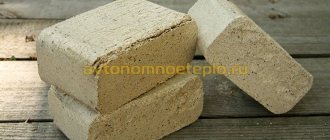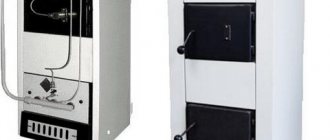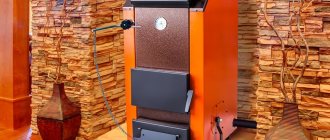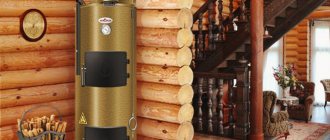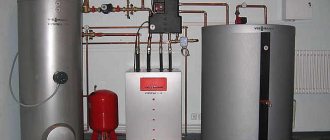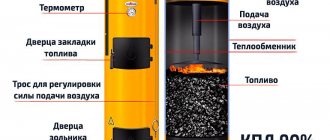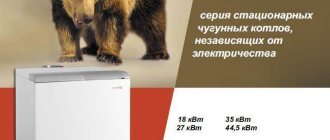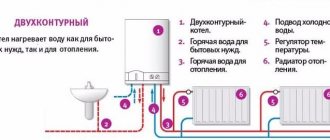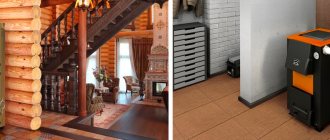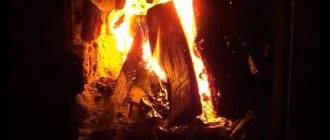The appearance on the market of solid fuel boilers with automatic feeding has greatly simplified the lives of many consumers for whom gas or electric heating is not available. The development of production has led to the creation of many models for various purposes. Knowledge about the structure, operating principles and types of automatic units will help you choose the most suitable and profitable option.
Features of boilers with automatic feed
The elements of the boiler installation, which are directly responsible for burning fuel and transferring heat to the home heating system, do not differ significantly from conventional solid fuel devices.
The main operational advantage of devices with automatic feeding is ensured by the presence of three basic components in their design:
- fuel bunker for one-time loading of large volumes of flammable materials;
- screw conveyor for regular transfer of fuel to the combustion chamber;
- complex automation responsible for the operation of the entire system.
The listed design elements provide the possibility of long-term combustion without additional maintenance of the boiler installation. To operate such equipment, human intervention is required no more than once every 1–2 weeks, and sometimes less often.
The automation also regulates the amount of fuel supplied, which depends on the current coolant temperature and the one set in the settings. When the bin is almost empty, the system notifies you to fill it.
Many models also feature the ability to automatically remove combustion products. That is, the entire process from ignition to cleaning in such units is carried out without human intervention.
Rating of solid fuel boilers TOP-9 boilers
- Types of solid fuel boilers and their features
- Rating of classic TT boilers for heating a private home
- TOP - 3 long-burning solid fuel boilers
- Rating of boilers with automatic fuel supply
- Conclusion
Modern solid fuel boilers for heating a private home or cottage are quite efficient and reliable heating devices, which, in the absence of natural gas, demonstrate the highest economic performance. Another common area of application for solid fuel boilers is as a backup heat source for a private home, the main heating system of which runs on natural or liquefied gas.
Many technological solutions, different types of solid fuel and different combustion principles create a lot of inconvenience for the unprepared consumer when choosing the optimal option for solid fuel heating equipment. Teplomatika engineers have prepared a small rating of the best solid fuel boilers, which will help the future owner of a private home make an informed and justified choice.
All modern solid fuel boilers, with a small degree of convention, can be divided into three main classes, each of which has characteristic technical differences:
- classic heating devices have an open combustion chamber for wood, coal or fuel briquettes. Boilers of this type operate on natural draft, and the regulator for changing the power is a mechanical valve control device. Boilers of this type are, as a rule, non-volatile, but the total combustion time of the fuel does not exceed several hours;
- a more advanced class of heating equipment is long-burning boilers. Increasing the time of complete combustion of fuel is achieved either by vertical loading of fuel, or by using pyrolysis of coal or wood during the combustion process. The operating time of such devices on one load can reach 12 hours;
- Fully automated solid fuel boilers operate on fine coal, for storage and supply of which a special bunker is installed on the boiler. The battery life of such devices is several days and depends only on the volume of the bunker. Pellet heating systems represent a separate type of heating equipment, the review and rating of which will be presented in a separate article.
Practical advice on choosing a boiler for heating a private home
- when calculating the required power, you can use the approximate formula - for 10 m² of heated area, 1 kW of heating device power is required;
- Do not blindly trust advertising indicators of the maximum burning time of one load of fuel. As a rule, the actual burning time parameters, at severe negative temperatures outside the window, are several times lower;
- when choosing a non-volatile boiler for systems with natural coolant circulation, it is better to exclude products with a cast iron heat exchanger. Cold return water, with the heat exchanger already heated, can lead to the formation of cracks at the point of its supply;
- long-burning heating equipment places very serious demands on the quality of fuel - the maximum moisture content of firewood should not exceed 15%;
- The volume of the ash box determines the frequency of its cleaning - the larger the volume, the less often it is necessary to remove ash;
- a small chimney and lack of ventilation in the boiler room often lead to smoke in the room due to the lack of sufficient draft. This feature determines a large number of negative reviews on various sites, but is in no way related to the quality of heating equipment;
- Not all heating devices allow the use of antifreeze as a coolant. In this regard, it is better to consult with a specialist or look for information on the manufacturers’ websites.
| Category | Place | Name | Country of origin |
Rating of classic TT boilers for heating a private home | 1 | ACV Radijator C25 | Belgium |
| 2 | Zota Topol-M 20 | Russia | |
| 3 | Bourgeois K MODERN – 16 | Russia | |
| 4 | Kentatsu Elegant 03 | Türkiye | |
TOP - 3 long-burning solid fuel boilers | 1 | ACV Radijator FK1 | Belgium |
| 2 | Zota Bulat 18 | Germany | |
| 3 | Bourgeois K MODERN – 16 | Russia | |
| Rating of boilers with automatic fuel supply | 1 | Kentatsu VULKAN PR-30P | Belgium |
| 2 | Zota Forta 20 | Russia |
The rating of classic solid fuel boilers is presented by models from both foreign and domestic manufacturers. Ways to improve this type of technology lie in the plane of improving the quality of the metal used and designing an original shape of the combustion chamber, the design of which increases the burning time of the fuel.
Rating of classic TT boilers for heating a private home
1. ACV Radijator C25 is a solid fuel boiler from Serbia from the Radijator plant, which has recently been part of the well-known Belgian ACV group. The device with a steel heat exchanger has an installed power of 25 kW, which allows heating rooms up to 250 m². A distinctive feature of the ACV Radijator C25 is the material of the three-pass heat exchanger - European quality steel, increased to 5 mm in thickness. Laser cutting of firebox elements and their welding using automated welding complexes guarantee the reliability of the heat exchanger, and European quality standards for welds will determine its durability.
Models in the line:
- Radijator C25
- Radijator C40
- Radijator C50
Advantages:
- the heating device includes a copper heat exchanger, which serves as a signal source for triggering the thermal safety valve;
- three-pass combustion chamber design increases heat extraction during fuel combustion and increases the performance of the heating device;
- ACV Radijator C25 is designed to work with all types of fuel (firewood, briquettes, coke, biomass), but shows maximum efficiency with coal;
- There is a technological hole on the bottom door of the heating device for installing a gas or diesel fan burner.
Flaws:
- The limited accuracy of mechanical traction control can lead to slight excess fuel consumption.
Expert opinion: an excellent boiler from Serbia, which implements the developments of a famous Belgian manufacturer. The only serious drawback of the ACV Radijator C25 is its price, which is significantly higher than its Russian analogues.
2. Zota Topol-M 20 - a domestic solid fuel model with a maximum thermal power of 20 kW allows you to heat rooms up to 200 m². The Topol series is already the third modification of solid fuel equipment from the Krasnoyarsk manufacturer, the development of which was based on the operating experience of previous series. Thus, in this series of heating devices, a horizontal heat exchanger with a removable cover is installed, which significantly increases the heat transfer area and increases the efficiency of the heating system. Two large doors make it easy to load different types of fuel - the top door is for coal, and the bottom door is for firewood. It is also convenient to clean the heating device and service it through the top door.
Models in the line:
- Topol-M 14
- Topol-M 20
- Topol-M 30
- Topol-M 42
- Topol-M 60
- Topol-M 80
Advantages:
- a thermometer on the front panel increases the convenience of controlling the operation of the heating device;
- in the Zota Topol-M body there is a technological hole for installing an electric heating element, which is purchased additionally;
- The optional TurboSet automation kit improves the combustion mode of coal or wood and almost doubles the operating time on one load.
Flaws:
- a mechanical draft regulator is available as an option. In normal mode, manual traction adjustment is provided using a screw;
- Many owners of Zota Topol-M 20 complain about the small volume of the ash box.
Expert opinion: a simple, reliable and inexpensive TT boiler, the capabilities of which are significantly expanded by installing additional heating and automation devices.
3. Kentatsu Elegant 03 - an inexpensive Turkish-assembled model with a power of 17 kW allows you to heat residential and industrial premises with an area of up to 170 m². Heating appliances of the Elegant series have a massive cast-iron heat exchanger, the production of which uses Amin Gas technology. The resulting very smooth surface of the heat exchanger qualitatively reduces hydraulic resistance, which has a positive effect on the uniformity of temperature distribution and the overall reliability of the equipment. A spacious combustion chamber increases the volume of loaded fuel, and a wide, convenient door makes loading it easier. The maximum power of the Kentatsu Elegant 03 is achieved on coal, but this unit also works well on other types of fuel - wood or fuel briquettes.
Models in the line:
- Elegant 03
- Elegant 04
Advantages:
- additional heat exchanger fins along the path of removing burnt gases increases the overall efficiency of fuel combustion;
- The included mechanical thermostat allows you to regulate the temperature of the coolant by changing the draft;
- a thermometer installed on the front panel improves the conditions for monitoring the parameters of the heating system;
- water-filled grates increase heat extraction and prevent their deformation under the influence of high temperatures.
Flaws:
- some buyers complain about the build quality of the outer casing and the insulation fastening.
Expert opinion: an inexpensive heating device of a classic design with a good price-quality ratio.
4. Lemax Forward - 16 - the cheapest model of the classic version of solid fuel heating appliances from the Russian manufacturer has a maximum thermal power of 16 kW, which is quite enough for heating a private house or cottage with an area of up to 160 m².
The Lemax Forward series is optimized for burning coal or coke, but firewood or fuel briquettes can be used as backup fuel. Top loading ensures uniform distribution of coal throughout the entire volume of the firebox by simply pouring coal from a bucket or appropriate container.
A distinctive feature of Lemax Forward - 16 is the alloy steel of the Magnitogorsk plant for the manufacture of the firebox, the thickness of which is 4 mm. Together with gray cast iron grates, this feature of the combustion chamber guarantees high reliability and durability of the heating device.
Models in the line:
- Lemax Forward-12.5
- Lemax Forward-16
- Lemax Forward-20
Advantages:
- treating the heat exchanger with inhibitory compounds eliminates the likelihood of its intense corrosion;
- with a full load of coal and its top ignition, the burning time increases to 8-12 hours, which is a very good value for boilers of this type;
- The upper large door for loading coal provides convenient access to all technological surfaces for their periodic cleaning.
Flaws:
- When heating with wood or fuel briquettes, the operating time on one load does not exceed 2-3 hours, which must be taken into account when planning a purchase. Expert opinion: a simple and reliable model at a very attractive price requires certain skills in working with solid fuel heating devices. Otherwise, the impressions of working with equipment of this class will be very negative.
TOP - 3 long-burning solid fuel boilers
Long-burning solid fuel heating devices were the first step in the development of this type of technology, the main advantages of which include a significant increase in the operating time of the device on one load of firewood or coal.
1. ACV Radijator FK1 - a long-burning heating device from a manufacturer from Serbia has a maximum thermal power of 23 kW, which allows you to heat domestic or industrial premises with an area of up to 230 m². A distinctive feature of the Radijator FK1 is a sealed combustion chamber and forced air supply for uniform and long-lasting fuel combustion. The boiler is optimized to work with all types of fuel, but produces the best results when using coal.
Another design feature of the ACV Radijator FK1 is the water-cooled grate and vertical heat exchange surfaces. Such features increase the efficiency of the boiler and increase its efficiency to 85%.
Models in the line:
- ACV (ATsV) FK1
- ACV (ATsV) FK2
- ACV (ATsV) FK3
- ACV (ATsV) FK4
Advantages:
- this series of TT equipment implements active overheating protection, the signal source for which is a copper heat exchanger inside the combustion chamber;
- a smoke cutter when loading coal or firewood increases the comfort of working with the heating device;
- the thickness of the steel walls of the combustion chamber increased to 5 mm increases the durability of the heating system as a whole;
- a built-in thermal catalyst for combustion products increases the environmental qualities of the heating device.
Flaws:
- This heating device is not a non-volatile device - for the automation and fan to work, you must be connected to an alternating current network. Expert opinion: a very high-quality and expensive Serbian-made model, the high efficiency of which fully justifies the money invested.
2. Zota Bulat 18 - a long-burning model from a well-known manufacturer from Krasnoyarsk has a maximum thermal power of 18 kW, which is enough to heat rooms up to 180 m². An increased combustion cycle is achieved using a large-volume two-pass firebox design and the use of fireclay bricks along the way to remove burnt gases. A secondary air supply system is also used to burn unburned solid particles. Maximum performance and burning time are achieved with coal, however, Zota Bulat also shows good results with wood. Maximum convenience and results can be achieved by installing the TurboSet kit on the Bulat 18, which makes the boiler semi-automatic. In this case, the burning time increases by 50%.
Models in the line:
- Zota (Zota) Bulat 18
- Zota (Zota) Bulat 23
- Zota (Zota) Bulat 28
- Zota (Zota) Bulat 35
- Zota (Zota) Bulat 45
Advantages:
- in non-volatile mode, the operation of the device is regulated by the blower damper, on which an optional draft regulator can be installed;
- a removable hatch above the shaft for the passage of flue gases simplifies periodic maintenance of the heating device;
- The Zota Bulat body has a technological hole for installing electric heating elements, which act as a backup heat source.
Flaws:
- In reviews, many consumers complain about the insufficient door seal for loading coal or firewood, which they have to modify themselves.
Expert opinion: a good TT boiler in the mid-price category, the maximum capabilities of which are optimized for the installation of a turbocharging kit and a chimney of sufficient height with very good draft.
3. Bourgeois K MODERN - 16 - a non-volatile pyrolysis type model from a well-known Russian manufacturer has been in operation on the domestic market for more than 10 years and during this time has established itself as a reliable and economical source of heat supply for country houses or summer cottages. The power of the device is 16 kW, which is enough to heat a house with an area of up to 160 m². Among the distinctive features of Bourgeois K MODERN, it is necessary to note two combustion chambers. In one, wood burns slowly with limited access to oxygen, and in the other, the pyrolysis gases released in the first chamber burn. For high-quality combustion of pyrolysis gases, the design of the device contains tubes and injectors for supplying heated air. The special design of the boiler with two combustion chambers ensures almost complete combustion of wood, an efficiency of about 90% and an operating time on one load of 6 to 12 hours.
Models in the line:
- Bourgeois K MODERN-12
- Bourgeois K MODERN-24
- Bourgeois K MODERN-32
Advantages:
- The energy-independent method of pyrolyzing firewood is a very rare type of boiler technology - foreign models require electricity;
- fireclay lining of the combustion chamber allows the use of firewood with a humidity of up to 50%, however, this will have to partially sacrifice efficiency;
- The staggered system of heat exchange surfaces allows you to significantly increase the heat transfer coefficient to the coolant of the heating circuit.
Flaws:
- the efficiency indicated by the manufacturer is achieved only when the moisture content of the firewood is less than 20%, which requires certain measures for their storage;
- The rather difficult period of the boiler reaching its operating parameters requires certain skills when lighting it.
Expert opinion: an excellent non-volatile pyrolysis boiler, the low price of which compensates for the occasional minor shortcomings of the assembly. It should be noted that non-volatile pyrolysis devices without forced air injection are practically absent on the heating equipment market.
Rating of boilers with automatic fuel supply
In the rating of solid fuel boilers with full automation of the heating process, there are two models from well-known manufacturers that operate on fine coal. The widespread use of heating devices of this type is hindered by the widespread introduction of pellet heating systems, the operation of which is not associated with dust and dirt from the coal fraction.
1. Kentatsu VULKAN PR-30P is a universal automatic boiler with a maximum thermal power of 35 kW designed to work with pellets or coal with a grain size of no higher than 30 mm. Structurally, VULKAN PR-30P is a solid fuel unit with a three-pass combustion chamber, automatic coal supply, manual ignition and an air supply fan to optimize the combustion process. To increase efficiency, heat-resistant pipes with specially designed turbulators are installed along the path of flue gases.
Models in the line:
- Kentatsu Vulkan PR-30
Advantages:
- a convenient and functional control panel helps the owner set and maintain the basic parameters of the heating system, and also gives a signal about the end of coal in the bunker;
- The sealed hopper lid prevents the occurrence of reverse draft and combustion of coal in the place of its storage.
Flaws:
- the automatic charcoal ignition unit is present only in models with the letters PE in the model name after the digital power designation.
Expert opinion: a good model of automatic coal-fired heating appliances, the widespread use of which is hampered by a decent price and a large minimum thermal power.
2. Zota Forta 20 - a relatively inexpensive automatic coal boiler from the Krasnoyarsk manufacturer is designed to work with fine coal (Nut) and is designed for continuous operation on one load for up to 6-7 calendar days. Zota Forta 20 has a maximum thermal power of 20 kW, which allows you to heat houses with a total area of up to 200 m². The supply of coal from the storage area (bunker) to the combustion zone is organized using a gear motor, and to remove combustion products, a large-volume ash box is installed on the Zota Forta 20.
Models in the line:
- Zota Forta 12
- Zota Forta 15
Advantages:
- the universal design of the heating device allows you to install a coal bunker on both the right and left sides;
- optional expansion of the bunker capacity allows you to significantly increase the operating time on one load of coal;
- double protection of the coal supply gear motor increases the reliability of the fuel path;
- The large and convenient design of the ash box does not require frequent removal of ash.
Flaws:
- operation of automation in a continuous cycle of coal combustion requires the presence of an uninterruptible power supply in case of loss of the alternating current network;
- The design of the fuel supply unit is very demanding on the quality and size of coal. Using coal with a diameter greater than 20 mm may stop its supply.
Expert opinion: a good solution for automating solid fuel heating. Before purchasing, it is advisable to analyze the local market for the availability of fine coal.
Conclusion
The constant technical development of solid fuel heating systems determines the appearance on the market of quite expensive and high-tech devices, the operation of which no longer requires the constant presence of a person. Among the general trends in the solid fuel equipment market, it is worth noting a serious increase in sales of technically complex TT systems for heating country houses, as well as an increase in the number of installations of simple and inexpensive heating devices as a backup source of heat supply.
Types of boilers by type of fuel bunker
There are two types of loading devices: built-in fuel hopper and mechanized storage. The battery life and the area occupied by the boiler installation depend on which of them the unit is equipped with.
Built-in fuel hopper
Models with a built-in loading device are equipped with a container for solid fuel, which is located on top or on the side of the main chamber of the boiler. The advantage of this design is the relative compactness of the heating installation. However, in terms of battery life, models with a built-in bunker are inferior to units with mechanized fuel storage.
Mechanized fuel storage
Here, a separate room or part of a room with a connected flammable material supply system acts as a loading device. The volume of such storage is enough to accommodate a year's supply of fuel.
The models are distinguished by a complex electronic automatic control system, which fully regulates all work processes, as well as the presence of a remote control unit.
Automatic fuel supply methods
Based on the methods of fuel supply, units with a pneumatic conveyor and a screw transmission are distinguished.
The choice of design depends on:
- noise level during operation of the heating installation;
- power consumption;
- frequency of fuel delivery to the combustion chamber and other indicators.
Pneumatic conveyor
Combustible materials are delivered to the main chamber of the boiler using air, which is pumped under pressure. The advantage of such models is that fuel is supplied less frequently. As a result, the system will be able to operate without electricity for a longer time. However, the pneumatic conveyor makes more noise during operation and consumes a lot of electricity - about 1.5–2 kW/hour.
Screw transmission
This method is used in most household units and is considered the most reliable, but it is not ideal.
Feeding is carried out via a screw conveyor, which operates almost silently and consumes less electricity - about 80 W/hour. The feed speed is adjusted automatically.
The use of an auger guarantees the flow of fuel into the boiler, but if its length is more than 2 m, flammable materials are ground into dust.
Application and effectiveness
Coal boilers for heating a private home have found application in regions of Russia where there is no main gas supply, and there is also a shortage of other energy resources: firewood, electricity.
The popularity of coal is higher near major transport hubs, since large quantities of coal are mainly transported by rail.
In order to increase the efficiency of a coal boiler, it is necessary to perform a number of measures. They start by choosing a brand of coal. It is mined in mines and may contain 15-20% waste rock, which cannot burn and produces a lot of ash.
Unprocessed coal has an ash content of up to 30%. Therefore, for energy purposes, coal undergoes special processing at enrichment complexes, which increases the efficiency of units, for traditional coal devices up to 70-75%, and for automatic ones - almost up to 90%.
In addition, in order to increase the economical operation of the heating system of a house equipped with a coal-fired unit, it is necessary to take into account the following points:
- Do not use raw coal, since a significant part of the energy from the thermal cycle will be used to dry it.
- Monitor the condition of the chimney system and heating surfaces of the boiler; they must be clean.
- Provide sufficient air. In the room where the unit is installed, there must be effective triple supply and exhaust ventilation.
- Use thermostats in the operating circuit of an automatic coal boiler.
- Effectively insulate your home.
- Improve the in-house thermal circuit, install a circulation pump and an indirect hot water heating boiler.
Pellet automatic units
One of the most common types of heat generators is systems powered by wood pellets. The operating principle of pellet boilers is in many ways similar to other automatic units, but there are also characteristic features.
If you trace the similarities and differences, as well as the advantages and disadvantages of such models, it will be easier to choose the appropriate option.
Principle of operation
The basic design of pellet systems is no different from other common automatic heat generators. Combustible materials are loaded into the fuel bunker, from where they are gradually poured onto the screw conveyor. The shaft transfers the granules to the combustion chamber, where the coolants are heated.
Differences in operation can be seen at the fuel supply stage:
- After starting the auger, the mechanism directs the pellets first into a flexible hose or plastic tube, which dumps the pellets into a dispenser.
- In the metering device, the second shaft measures the required portions of fuel and moves them to the reed valve.
- The gate opens and the pellets are dumped onto a third auger, which transfers a measured amount into the firebox.
The described algorithm may vary slightly depending on the implementation of a particular model.
Advantages
The economic and operational benefits of pellet heating systems are mainly related to the merits of the type of fuel used.
Wood pellets are not inferior to traditional combustible materials in terms of calorific characteristics, but have a number of advantages:
- lower cost;
- economical consumption, which leads to longer operating time without additional loading;
- increased environmental friendliness;
- minimum amount of combustion products in the ash pan.
As for the advantages of the boilers themselves, as a rule, they are smaller in size compared to units operating on other types of fuel.
Flaws
In addition to the listed advantages, there are also disadvantages.
Since the flame in most pellet models has a horizontal direction, overheating of the boiler structural elements may occur. In addition, the efficiency and power of such equipment is lower.
Automatic boilers running on wood chips and coal
This option of automatic units should be preferred by residents of regions where the cost of coal is comparable to the price of pellets. Otherwise, their operation will cost more.
The main advantage is higher efficiency rates. However, coal emits a significant amount of soot and tar, which leads to less environmental friendliness. Equipment maintenance is carried out more often, as more ash is released during combustion.
For coal boilers, there is a requirement for the size of combustible material granules: from 4 to 25 mm in diameter. This is necessary for the smooth operation of the screw conveyor.
Fuel for long-burning boilers
Certain grades of soft coal with low slagging levels will be required. Long-flame coal with a T fraction of 25 mm is preferable. At exhibitions, the operation of automatic long-burning boilers is demonstrated using this type of “black” fuel. In this case, you get a beautiful flame with large and long tongues.
However, as soon as a potential buyer tries to find out the brand of coal, company representatives assure that the boiler runs on Polish coal, which is called ECO-PEAS. And they assure: the boiler will work just as well using our coal, and most importantly, efficiently and economically.
In practice, things are different:
- the boiler is purchased and installed;
- they purchase affordable coal on the local market without focusing on its quality;
- and they don’t get the expected fire “like at an exhibition.”
Everything is explained simply. This boiler is not designed to operate on any kind of coal. In Poland, coal is sold in sorting bags, already screened/screened, indicating the calorie content and the desired fraction, which is suitable for a specific type of boiler. “Size” coal will cost more (20-30%) than what is sold on the local market. However, Polish coal burns with a bright flame, has high efficiency and excellent calorific value.
Recommendations for selection
Choosing the most suitable model depends on many factors. First of all, you need to decide on the type of fuel, prices for which may vary depending on the region.
After this, it is worth calculating the area that is available for installing the boiler system, and taking into account the wishes for battery life. This will help you determine the most appropriate dimensions of the boiler and the capacity of the fuel bunker, which will significantly narrow your search.
To take full advantage of the potential economic and operational benefits of automatic boilers, you need to pay attention to the following parameters when choosing:
- boiler power (must correspond to the area of the heated room);
- availability of economical modes;
- demands on the quality of fuel, its ash content;
- reliability and safety of long-term battery life;
- reproduced noise in various modes;
- availability of automatic ignition and ash collection functions;
- electricity consumed;
- possibility of operation from rechargeable batteries;
- the size of the ash bin and the ease of cleaning it;
- efficiency of working with different types of fuel pellets and in different modes;
- the presence of a remote control or the ability to additionally connect it.
You also need to pay attention to the appearance of the boiler, including the quality of the welds.
Review of the best manufacturers and prices
There are many models of heating units available to the modern consumer. Making a choice in such a situation is quite difficult. Understanding popular models and manufacturers will help simplify the situation.
Germany
German-made boiler equipment is the standard of quality. The models have a high level of efficiency and operate without failures. It is not surprising that systems manufactured in Germany have the highest cost, about 450–600 thousand rubles.
First of all, it makes sense to pay attention to the heating systems Buderos, Heiztechnik and ThermoFLUX.
Prices for solid fuel boilers Buderos
solid fuel boilers Buderos
Italy
Among the Italian-made models there are many universal options. For example, Lamborghini Ecologik series boilers can operate on wood, coal, peat and briquettes. And after installing additional equipment (adapter door, pellet burner, auger and hopper), pellets will also be suitable as fuel.
Italian models have an average price category. Brands that have proven themselves in the market: Lamborghini, D'Alessandro Termomeccanica, Faci.
Prices for solid fuel boilers Lamborghini
Lamborghini solid fuel boilers
Türkiye
Turkish boiler systems belong to the middle price segment. They have a good quality automatic feeding system and are equipped with a convenient control panel. One of the most popular manufacturers is Totem, which produces silent boilers with easy temperature control. The brands Emtas and Termodinamik are also known.
Russia
Russian automatic boilers are in constant demand on the domestic market. Manufacturers have achieved significant success through the introduction of modern design methods, new manufacturing technologies and continuous improvement of designs.
The models have an attractive appearance, high-quality assembly, good automation and benefit in terms of price. Their cost starts from 80–100 thousand rubles, which is relatively inexpensive compared to imported analogues. The most famous brands: Danko, Pereko, Obshchemmash Peresvet, Obshchemmash Valdai, NMK Magnum.
Japan
Japanese products are characterized by a high degree of automation. Many additional built-in functions significantly increase ease of use. The models are also distinguished by an ergonomic shape and high-quality materials for manufacturing, usually steel with anti-corrosion treatment.
Prices for automatic solid fuel boilers made in Japan are not inferior to the cost of models from Germany. The most popular manufacturers: Kentatsu, Rinnai.
Prices for solid fuel boilers Kentatsu
solid fuel boilers Kentatsu
Serbia
The Serbian manufacturer Radijator produces universal, highly environmentally friendly units that are equipped with an overheating protection system and are resistant to ash deposits. Allows to obtain an efficiency of about 90%. Pass mandatory quality checks.
China
Most Chinese products are not of high quality and reliability. The exception is units of the Chinese brand Roda (the manufacturing country is usually Türkiye). The design of the models makes it easy to clean the flame tubes, which maintains high combustion efficiency. The average cost of such equipment is 150 thousand rubles. Check out the link for the best heating batteries for an apartment.
Firewood and coal in TT boilers
Today, heating with coal in Russia is unprofitable, which cannot be said about wood heating. Firewood In many regions of Russia, firewood is cheaper than gas, but from a practical point of view it has noticeable disadvantages:
- firewood must be prepared correctly;
- fuel burns quickly in the furnace compartment, so the process must be controlled;
- If the fire burns out completely, you have to periodically add firewood to the boiler.
As an alternative, many people choose coal. This is also a solid fuel, and also cheaper than gas. If you buy an automatic long-burning solid fuel boiler with automation, you will solve the problem of saving money and time (you don’t have to be on duty at the firebox). However, it must be taken into account that not all coal is good for TKDG.

